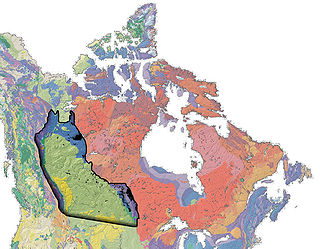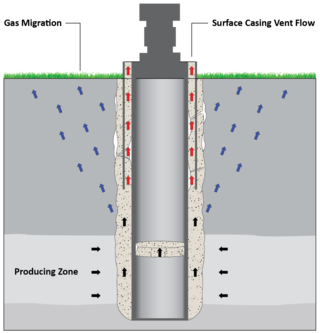
The Athabasca oil sands, also known as the Athabasca tar sands, are large deposits of bitumen, a heavy and viscous form of petroleum, located in northeastern Alberta, Canada. These reserves are one of the largest sources of unconventional oil in the world, making Canada a significant player in the global energy market.

Teck Resources Limited, known as Teck Cominco until late 2008, is a diversified natural resources company headquartered in Vancouver, British Columbia, that is engaged in mining and mineral development, including coal for the steelmaking industry, copper, zinc, and energy. Secondary products include lead, silver, gold, molybdenum, germanium, indium and cadmium. Teck Resources was formed from the amalgamation of Teck and Cominco in 2001.

The Canadian Association of Petroleum Producers (CAPP), with its head office in Calgary, Alberta, is a lobby group that represents the upstream Canadian oil and natural gas industry. CAPP's members produce "90% of Canada's natural gas and crude oil" and "are an important part of a national industry with revenues of about $100 billion-a-year ."
The Ministry of Energy is a Cabinet-level agency of the government of the Canadian province of Alberta responsible for coordinating policy relating to the development of mineral and energy resources. It is also responsible for assessing and collecting non-renewable resource (NRR) royalties, freehold mineral taxes, rentals, and bonuses. The Alberta Petroleum Marketing Commission, which is fully integrated with the Department of Energy within the ministry, and fully funded by the Crown, accepts delivery of the Crown's royalty share of conventional crude oil and sells it at the current market value. The current ministry was formed in 1986, but ministries with other names dealing with energy resources go back to the Ministry of Lands and Mines in 1930.
Steam-assisted gravity drainage is an enhanced oil recovery technology for producing heavy crude oil and bitumen. It is an advanced form of steam stimulation in which a pair of horizontal wells are drilled into the oil reservoir, one a few metres above the other. High pressure steam is continuously injected into the upper wellbore to heat the oil and reduce its viscosity, causing the heated oil to drain into the lower wellbore, where it is pumped out. Dr. Roger Butler, engineer at Imperial Oil from 1955 to 1982, invented the steam assisted gravity drainage (SAGD) process in the 1970s. Butler "developed the concept of using horizontal pairs of wells and injected steam to develop certain deposits of bitumen considered too deep for mining". In 1983 Butler became director of technical programs for the Alberta Oil Sands Technology and Research Authority (AOSTRA), a crown corporation created by Alberta Premier Lougheed to promote new technologies for oil sands and heavy crude oil production. AOSTRA quickly supported SAGD as a promising innovation in oil sands extraction technology.

The Western Canadian Sedimentary Basin (WCSB) underlies 1.4 million square kilometres (540,000 sq mi) of Western Canada including southwestern Manitoba, southern Saskatchewan, Alberta, northeastern British Columbia and the southwest corner of the Northwest Territories. This vast sedimentary basin consists of a massive wedge of sedimentary rock extending from the Rocky Mountains in the west to the Canadian Shield in the east. This wedge is about 6 kilometres (3.7 mi) thick under the Rocky Mountains, but thins to zero at its eastern margins. The WCSB contains one of the world's largest reserves of petroleum and natural gas and supplies much of the North American market, producing more than 450 million cubic metres per day of gas in 2000. It also has huge reserves of coal. Of the provinces and territories within the WCSB, Alberta has most of the oil and gas reserves and almost all of the oil sands.

The Kearl Oil Sands Project is an oil sands mine in the Athabasca Oil Sands region at the Kearl Lake area, about 70 kilometres (43 mi) north of Fort McMurray in Alberta, Canada that is operated by the 143-year old Calgary, Alberta-headquartered Imperial Oil Limited—one of the largest integrated oil companies in Canada. Kearl is owned by Imperial Oil and is controlled by Imperial's parent company, ExxonMobil—an American multinational that is one of the largest in the world.
The Pennsylvania Department of Environmental Protection (DEP) is the agency in the U.S. state of Pennsylvania responsible for protecting and preserving the land, air, water, and public health through enforcement of the state's environmental laws. It was created by Act 18 of 1995, which split the Department of Environmental Resources into the Department of Environmental Protection and the Department of Conservation and Natural Resources. Its current secretary is Jess Shirley.

Canada has access to all main sources of energy including oil and gas, coal, hydropower, biomass, solar, geothermal, wind, marine and nuclear. It is the world's second largest producer of uranium, third largest producer of hydro-electricity, fourth largest natural gas producer, and the fifth largest producer of crude oil. In 2006, only Russia, the People's Republic of China, the United States and Saudi Arabia produce more total energy than Canada.
Ecojustice Canada, is a Canadian non-profit environmental law organization that provides funding to lawyers to use litigation to defend and protect the environment. Ecojustice is Canada's largest environmental law charity.
The Energy Resources Conservation Board (ERCB) was an independent, quasi-judicial agency of the Government of Alberta. It regulated the safe, responsible, and efficient development of Alberta's energy resources: oil, natural gas, oil sands, coal, and pipelines. Led by eight Board members, the ERCB's team of engineers, geologists, technicians, economists, and other professionals served Albertans from thirteen locations across the province.
Through the 1996 Electric Utilities Act the Alberta's deregulated electricity market began.
The Ministry of Environment and Protected Areas of Alberta is the Alberta provincial ministry of the Executive Council of Alberta responsible for environmental issues and policy as well as some, but not all, parks and protected areas in Alberta.

Oil sands tailings ponds are engineered dam and dyke systems used to capture oil sand tailings. Oil sand tailings contain a mixture of salts, suspended solids and other dissolvable chemical compounds such as acids, benzene, hydrocarbons residual bitumen, fine silts and water. Large volumes of tailings are a byproduct of bitumen extraction from the oil sands and managing these tailings is one of the most difficult environmental challenges facing the oil sands industry. An October 2021 Alberta Energy Regulator (AER) report said that in 2020 the tailings ponds increased by another 90 million cubic meters and contained 1.36 billion cubic metres of fluids.

Fracking in Canada was first used in Alberta in 1953 to extract hydrocarbons from the giant Pembina oil field, the biggest conventional oil field in Alberta, which would have produced very little oil without fracturing. Since then, over 170,000 oil and gas wells have been fractured in Western Canada. Fracking is a process that stimulates natural gas or oil in wellbores to flow more easily by subjecting hydrocarbon reservoirs to pressure through the injection of fluids or gas at depth causing the rock to fracture or to widen existing cracks.
The Oil and Gas Operations Act is a legislation that legally gives the Government of the Northwest Territories the right to govern onshore “exploration, production, processing and transportation of oil and gas resources in the Northwest Territories”.

Orphan wells in Alberta, Canada are inactive oil or gas well sites that have no solvent owner that can be held legally or financially accountable for the decommissioning and reclamation obligations to ensure public safety and to address environmental liabilities.
The Canadian province of Alberta faces a number of environmental issues related to natural resource extraction—including oil and gas industry with its oil sands—endangered species, melting glaciers in banff, floods and droughts, wildfires, and global climate change. While the oil and gas industries generates substantial economic wealth, the Athabasca oil sands, which are situated almost entirely in Alberta, are the "fourth most carbon intensive on the planet behind Algeria, Venezuela and Cameroon" according to an August 8, 2018 article in the American Association for the Advancement of Science's journal Science. This article details some of the environmental issues including past ecological disasters in Alberta and describes some of the efforts at the municipal, provincial and federal level to mitigate the risks and impacts.
The Grassy Mountain Coal Project was a proposed open-pit mine to produce metallurgical coal, initially submitted to the Alberta Energy Regulator by the Australian-based Benga Mining in 2015. The proposed mine was located on a previously abandoned mine site near Crowsnest Pass, Alberta, Canada in the eastern slopes of the Rocky Mountains. In their June 17, 2021 final report, the joint provincial-federal review panel composed of the Alberta Energy Regulator (AER) and the Minister of Environment and Climate Change Canada (ECCC) denied Benga Mining's application for the Grassy Mountain Coal Project because of significant adverse environmental effects.
Selected timeline related to orphan wells in Alberta, Canada is a list of events relevant to orphan wells in Alberta, Canada. Orphan wells are inactive oil or gas well sites that have no solvent owner that can be held legally or financially accountable for the decommissioning and reclamation obligations to ensure public safety and to address environmental liabilities.








